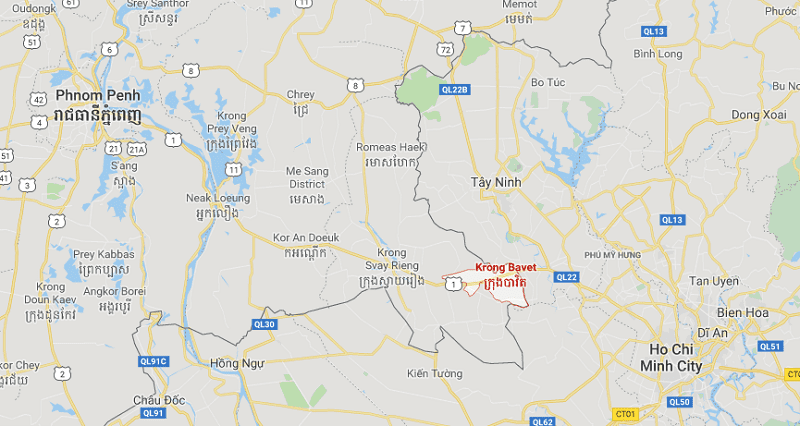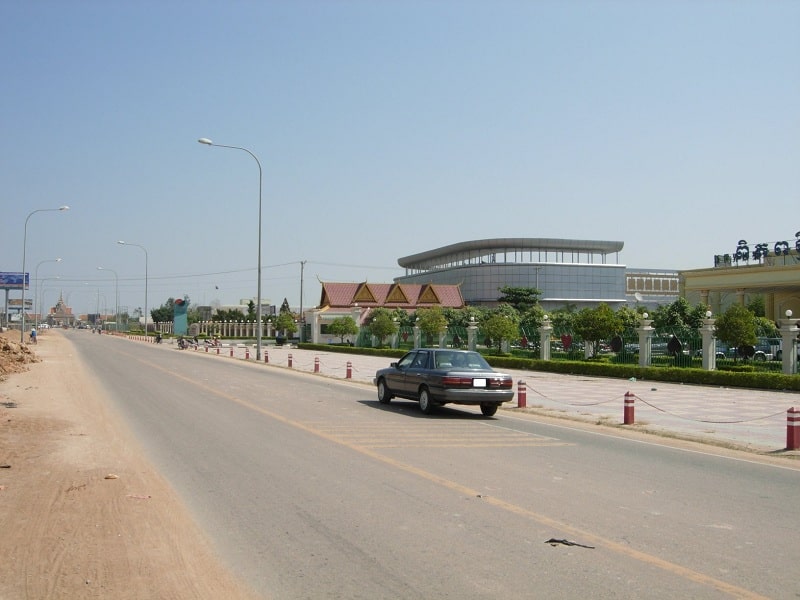The ultimate guide to Bavet

Countries don’t become rich by just buying and selling things within their own borders. In this modern age of globalisation, countries are more connected than ever. Bavet, Cambodia is the nexus of trade and movement between the Kingdom and Vietnam, its eastern neighbour.
Bavet, the largest city in Svay Rieng province, is home to one of the four border crossings between Cambodia and Vietnam. It has become the de facto point of entry for overland shipping between the two countries. This is mainly due to its location midway between Phnom Penh and Ho Chi Minh City.
Bavet has become a hub for not only trade but gambling, investment and even land speculation. It has attracted attention from many Chinese investors because of its status in the region.
This guide will walk you through Bavet’s SEZs, its gambling industry, Bavet Satellite City, land prices and what the future will look like. Read on to learn all about one of Cambodia’s most interesting border cities.
If you want a free crash course on the business scene in Cambodia, go and download our free Investment Guide 2019.
Bavet the boomtown

Bavet sits right on the border that Cambodia shares with Vietnam. Years ago it was a dusty town that even Cambodians were unfamiliar with. But that was before it got a special economic zone and began developing its tourism industry.
Gaming licences had been issued by the government many years before Chinese investors began pouring in. Yet online gambling is one of the main industries that investors from there brought to the town in recent years.
Over the last few years, along with the development of the casinos in Bavet, the local economy has grown. A host of factories have begun operating in the province’s 10 special economic zones, and the real estate market has expanded.
Currently, Bavet boasts a population of over 50,000, most of the country’s special economic zones, 56 factories, 17 casinos and hotels and more on the way.
Fortunately, prices haven’t shot up as they did in Sihanoukville after the surge in Chinese-run businesses.
SEZs generate prosperity
According to a senior government official in Bavet, investments from China have been key to the development of the area’s many Special Economic Zones (SEZs).
The government began its program for SEZs back in 2005. This marked a turning point for the economy of Bavet, and the entire province of Svay Rieng. The Manhattan Special Economic Zone was the first private industrial park in the country. It remains a staple of industry in Bavet. A total of four SEZs have been built in Bavet, and six in nearby areas of Svay Rieng.

In Bavet alone there are nearly 60 factories in the SEZs employing more than 40,000 people.
Because of the city’s proximity to Vietnam, it is a hub of cross-border trade. The rise of the gambling industry there has also jumpstarted investment in the area. Additionally, there are a couple key advantages that gives the city an edge:
- Being located just north of the Mekong River Delta means Bavet is drought resistant. There is an abundance of water sources.
- Electricity is stable. This means that the area rarely suffers from outtages.
In recent years, as export markets grow, activity in Bavet’s SEZs has increased. Manufacturers from the United States, Japan, Malaysia, Vietnam and Hong Kong have also set up factories in the SEZs to manufacture garment, shoes and other products, providing a large number of employment for the locals.
Bavet’s booming gaming industry

On the way from Bavet to the Vietnamese border, there are many casinos scattered along National Road 1. Indeed, Bavet seems to mirror the activity of Poipet on the other side of the country. Read more about that area in our ultimate guide to Poipet. Both areas have many casinos that cater to foreign visitors.
You see, gambling is illegal in both Vietnam and Thailand. It’s illegal in Cambodia, too, but only for its citizens. Foreign visitors are free to lay bets. Because of this unique situation, Cambodia has become somewhat of a gambling Mecca for Southeast Asia in recent years. Tourist travel from all over the region to visit. To read more about the gaming industry in Cambodia, read our Ultimate guide to casinos in Cambodia.
Interestingly, Bavet’s casinos seem to be geared towards visitors stopping in for a day or two. Since the city is at a crossroads the turnover is quick. The growth of Bavet’s gaming industry has led to a renewed interest in hotels, restaurants, markets and other key types of real estate.
Land prices on the rise
According to the chairman of the Cambodia Real Estate Association, demand is growing for more residential options in Bavet. This follows the growth of businesses and a population growth, as well.
At the moment, the price of land near the centre of town area or adjacent to the casinos is between $1,000 and $2,000 per sqm.
On secondary roads in the city land costs between $400 and $500 per sqm. Land off National Road 1, on the other hand, goes for just $100 to $200 per sqm.
Bavet Satellite City
In October of 2018, three Chinese companies announced joint plans for a satellite city project in Svay Rieng province. Empire World City, Bauing and China CFMA said they were planning a development that will cover 800 hectares and cost roughly $500 million.
According to local media, a 50-hectare residential development within the satellite city is already in the works. Eventually, the satellite city will have houses, parks, entertainment venues and factories.
A timeline of 15 years was initially laid out for the project. Estimates claim the project aims to host around 200,000 people.
The future of Bavet

In February 2018, representatives from the Cambodian and Vietnam governments met to discuss the development of roads and railways linking the two nations. Sun Chanthol, the minister of Public Works and Transport for Cambodia, at that time suggested that Vietnam build a railway connecting Bavet and Ho Chi Minh City.
Luckily, the idea is progressing forward. An assessment has been done. Findings show that the 130-km line would cost around $3.8 billion. High costs were attributed to the fact that 80 km of the line would have to cross lakes and floodplains.
Another light on the horizon is the plan to create a highway linking Ho Chi Minh and Phnom Penh. Vietnam, Cambodia, China, Taiwan and Japan have all pledge to support efforts to boost trade links in the region.
As we see more an more of these projects come to fruition, the future looks ever brighter for Bavet and Svay Rieng in general. There’s no doubt that it will become a key area in regional business in the years to come.
